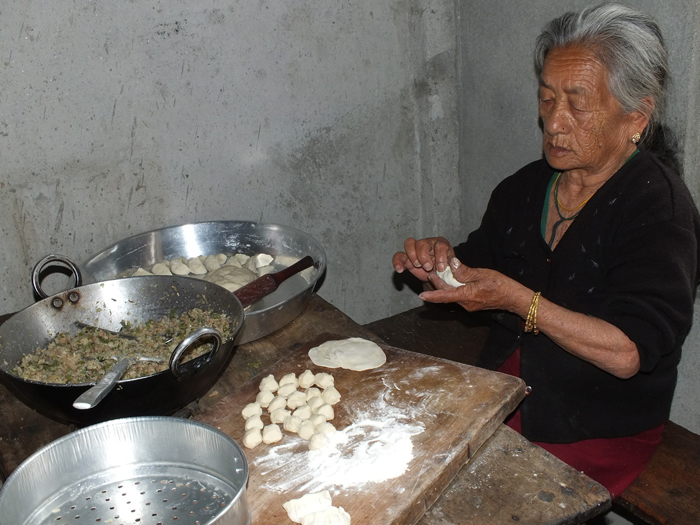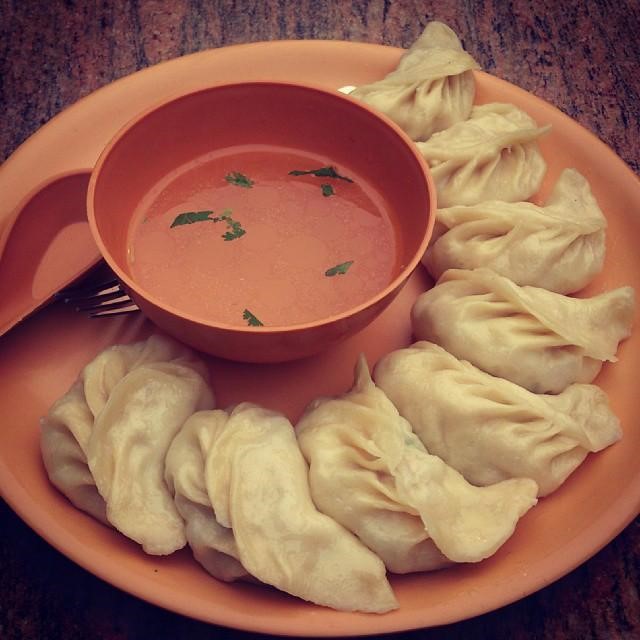Sikkim
The erstwhile Himalayan kingdom of Sikkim became part of the Indian Union in 1974. As part of the Eastern Himalayas the hilly terrain of Sikkim rises from the tropical jungles at the foothills and ascends to high alpine valleys and lofty peaks. Kanchenjunga, the third highest peak in the world is located at the Singalila range which forms a boundary between Nepal and Sikkim. This mountain state is bounded by Tibet on the north, Bhutan on the east and south and Nepal on the west. This particular location of Sikkim has given the state a multicultural and multi-ethnic character. The main ethnic groups in the Sikkim hills are the Lepchas, Bhutias and Nepalis and accordingly the cuisine of Sikkim is representative of these communities. Over time, communities from the mainland have migrated to Sikkim and have brought with them their special foods to the hills. The food culture in the Eastern Himalayas of Sikkim has evolved over a period of time based on environmental, social and cultural factors and certain dishes have transcended cultural and territorial borders and have come to be embraced by all communities in Sikkim. These include dishes like the patlesishnu or souchya (nettle soup), thukpa (wheat noodle soup) and titeningro (fern curry with chhurpi or cottage cheese). Besides these, there is one dish which has truly broken barriers of culture, language and imagination to overtake the street food market in India, the momo.
The momo is a special dish of Tibet. It is a dumpling, a type of dish consisting of pieces of dough filled with meat or vegetable stuffing which is then steamed on a special steamer called the mucktoo.
There are many different variations of the momo in the world and are known by names like the khinkali in Georgia, mandu in Korea, pelmeni in Russia, periogi in Poland, gyoza in Japan and jiaozi in China. The history of this sumptuous dish is traced to China during the third century A.D. At the time of the decline of the Han dynasty there lived a physician, Zhang Zhongjing, who devised a cure for frostbite by boiling a concoction made of dough, meat, chillies and herbs. It is not known if the cure was successful. However, the dish became a culinary fixture in many Asian and East European cultures.
The original Tibetan momo which made a long journey from this mountainous citadel to other climes and lands in South Asia, is made of a filling of yak meat and onion wrapped inside a dough. The momo was brought to Sikkim by the Bhutias sometime in the fourteenth century when they settled down there. They forged relations with the native population and established a bond of blood brotherhood with the Lepchas and the Limbus. Momo soon travelled from the Bhutia kitchens to the other communities. The communities welcomed the momos into their hearth and heart and the journey of the momo began in Sikkim.
The momo is a traditional dish which is made during formal occasions in a Tibetan household. The momo-making operation is a very laborious one indeed and requires a team approach. It is a difficult task for an individual to undertake single-handedly. In this way the momo is quite a social dish in that it takes a family to make and a village to consume. First the dough is prepared from equal parts of flour (maida) and whole wheat flour and water. A bit of baking soda is added to the mix for texture. The dough is kept aside for a while as the filling is prepared. The filling can be prepared from a host of ground meats and vegetables.
The ingredients for traditional Tibetan beef or lamb momo filling are ground beef or lamb, hot water, finely chopped celery, finely chopped green onion, salt, ground cumin seeds, grated nutmeg and ground ginger. All these units are combined in a large bowl and the next part of the operation is attended to. The dough is broken up into small balls and rolled into a round disk, around four inches across. Then the rolled dough is filled with a teaspoon of the filling. The circle is then closed in half and the dough is sealed by a folding procedure which is quite complicated and requires practice to master.
There are many alternative ways of folding the dough and each one requires some mastery in pinching the dough at the edges to securely pack the dough so that the juice is retained during the steaming process. The steamer or mucktoo is greased with butter or oil and then the prepared pieces of stuffed dough are placed accordingly. The steaming process takes around thirty minutes. The juicy and steaming momos are then taken out of the mucktoo and served piping hot.
In Sikkim and adjacent Darjeeling and Kalimpong districts, the momo is usually served with a clear soup and a spicy tomato and chilli sauce.
The momo has undergone many changes as it has travelled from Tibet to places like Nepal, Bhutan and India. In Nepal there is a momo variant locally known as momo-cha in the Kathmandu valley which is made from buffalo meat, ginger, garlic and local spices. In India the main areas where a thriving momo culture exists are in Sikkim, Ladakh and the North East. From these areas this tasty dish has travelled to other parts of India. In most major cities of India, a street vendor with the instantly recognizable mucktoo has become a common sight.
In the NCR (National Capital Region) momo has emerged as a much beloved cheap and affordable evening snack. Momo vendors can be seen lined up on the streets in market areas, both commercial and residential, with their makeshift stalls. These momos are served in three variations- vegetable, chicken and paneer- which are served with a spicy chutney (sauce) made of dry chillies or sometimes with mayonnaise. More elaborate stalls also have a facility to fry them. In marriages and parties tandoori momos (hybrid momo which combines Punjabi flavours with Tibetan) are served as snacks. Momo chain restaurants dedicated to serving the momo-loving public have emerged in India in recent times.
Thus, the momos have come a long way not only in terms of distance but also in cultural terms. The momo has evolved and now it comes in a variety of flavours and forms. Everywhere it has travelled it has managed to accommodate the host culture’s flavour and ingredients while retaining its original form. From simple momos to kothay momos (pan fried momo) to jhol momos (curry momo), this highland dish has become a true cultural and culinary phenomenon.
 Government of Indiaa
Government of Indiaa




 Recognizing the ongoing need to position itself for the digital future, Indian Culture is an initiative by the Ministry of Culture. A platform that hosts data of cultural relevance from various repositories and institutions all over India.
Recognizing the ongoing need to position itself for the digital future, Indian Culture is an initiative by the Ministry of Culture. A platform that hosts data of cultural relevance from various repositories and institutions all over India.
